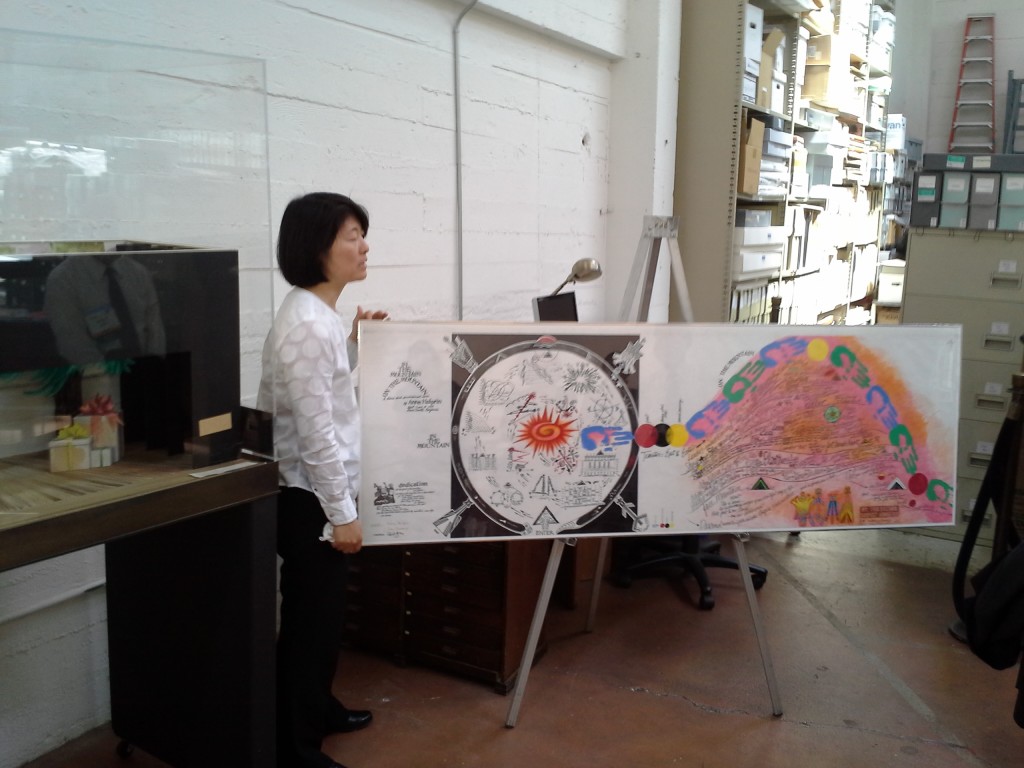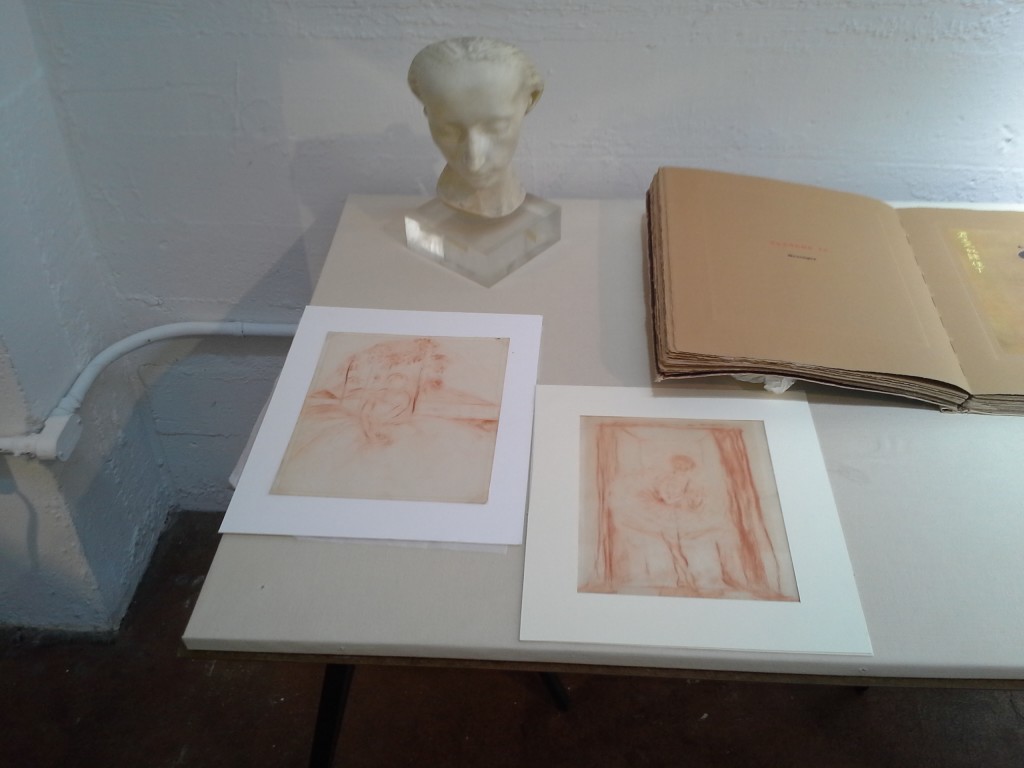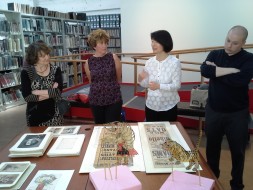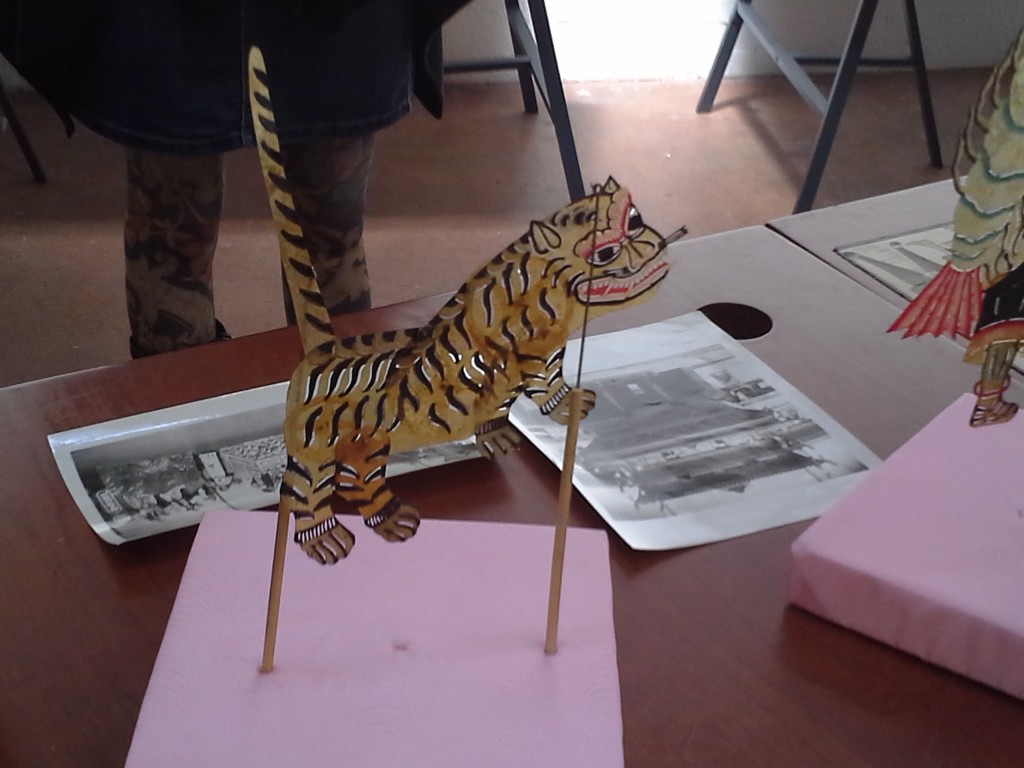Inside the Museum of Performance + Design
(Left:Kirsten Tanaka shows off some of Museum of Performance + Design’s treasures. Photo by John Calhoun.)
Before the ribbon was cut at the American Library Association’s 2015 conference on June 26, several Theatre Library Association members took the time to enjoy a tour of San Francisco’s Museum of Performance + Design (MP+D). Founded in 1947 by Russell Hartley, a San Francisco Ballet dancer and designer, this institution has evolved considerably since its beginnings, expanding its mission to document Bay Area performance from the mid-19th century Gold Rush days to the present. Leading the tour at MP+D’s current Folsom Street headquarters in the South of Market district was head librarian/archivist Kirsten Tanaka, who showed off some of the museum’s treasures and described its activities.
The museum houses about 3.5 million items in its 5,000 sq. ft. building and offsite facility. These holdings range from books, playbills, photographs, posters, broadsides, scrapbooks, biographical files, sheet music and three-dimensional items like costumes and stage models. The archives of San Francisco Ballet and San Francisco Opera are represented as well as the personal papers of opera star Gladys Swarthout, dancer/choreographer Anna Halprin, and playwright Paul Gerard Smith, among many others. There are archival records documenting the city’s major theatre companies and buildings; a theatre film archive of about 500 productions (open on a restricted basis to Actors’ Equity members and other qualified theatre professionals), plus a number of other performance videos; local radio archives; and an oral history project for San Francisco performing artists.

Kirsten Tanaka shows an Anna Halprin dance score for “In the Mountain On the Mountain” during the June 2015 tour of the Museum of Performance and Design. Photo by John Calhoun.
On the tour, Tanaka presented artifacts documenting San Francisco performance history: a model of the War Memorial Opera House stage; a sculpted cherub from the Fox Theatre movie palace (designed by Thomas W. Lamb and demolished in 1963); a color panel dance score for Anna Halprin’s In the Mountain On the Mountain; several animal skin Chinese shadow puppets; and two Anna Pavlova self-portraits. Only four life masks of the prima ballerina are known, and tour guests got a chance to see one in the MP+D holdings. It was a colorful array that gave just a taste of the museum’s unique collections.
MP+D has faced its share of challenges over its 68-year history. Founded by Hartley as the San Francisco Dance Archives (later the Archives for the Performing Arts), the collection for a time was part of San Francisco Public Library system. After a period of expansion and a couple of relocations, the organization became formally know as the San Francisco Performing Arts Library and Museum in 1989. Another move in 1999 gave the museum, renamed MP+D in 2007, an expansive space in the Veterans Building at the San Francisco War Memorial and Performing Arts Center. But the Veterans Building closed for seismic upgrade and renovation in 2013, and the grant- and donation-dependent MP+D was compelled to move into its present location with a smaller staff, including executive director Muriel Maffre and dedicated San Francisco Ballet archivist Supriya Wronkiewicz in addition to Tanaka.

Two Anna Pavlova self-portraits and a life mask at the Museum of Performance + Design. Photo by John Calhoun.
Nonetheless, the museum continues to maintain a robust exhibition and programming profile. At the time of the tour the exhibit Latifa Medjoub: Sublimated Masks, showcasing costumes and fiber sculptures created for the Collected Works production of Genet’s The Balcony, had just closed. A performance salon featuring dancer Alessio Silvestrin was held the evening after the tour. The museum has partnered on an ongoing online exhibit of Russian choreographer Leonid Yakobson’s photographs and films. And an offsite exhibit of San Francisco Ballet and San Francisco Opera ballet posters is on display through 2016 at the War Memorial Opera House.
Now in its third year of a five-year lease on Folsom Street, MP+D may be faced with another relocation in 2018, skyrocketing San Francisco real estate prices being what they are. But Tanaka says that its mission to “keep the unfolding history of the performing arts in the San Francisco Bay Area alive” and to “collect, preserve and interpret materials on performance and theater design to support learning, appreciation and creativity within a world-wide community of artists, researchers and the general public” will remain alive.
For more information about the Museum of Performance + Design’s collections, exhibitions, and research hours, visit their website at http://www.mpdsf.org/.
John Calhoun, Librarian III
Billy Rose Theatre Division
New York Public Library for the Performing Arts


